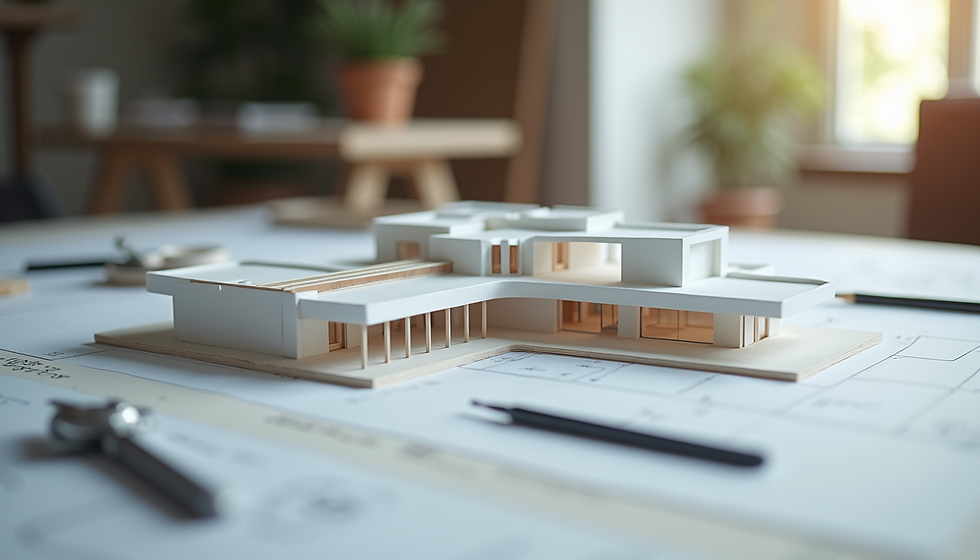Uncovering the Impact of AI on Sustainable Architecture for Mid-Sized Firms
- Mathew Kaplan
- Apr 18
- 4 min read

The architecture industry is changing fast, fueled by technology that prioritizes sustainability. Artificial Intelligence (AI) leads this charge, offering tools and insights for mid-sized architectural firms to reduce their environmental impact while optimizing their operations. This blog post will look at how AI is transforming sustainable architecture, allowing firms to create eco-friendly designs, improve efficiency, and adopt sustainable practices.
Understanding AI in Architecture
AI refers to computer systems capable of performing tasks usually needing human intelligence, including data analysis and decision-making. In architecture, AI’s strength lies in analyzing huge amounts of data, simulating design scenarios, and suggesting optimal solutions, all crucial for sustainable designs.
For instance, AI can evaluate energy usage patterns to help architects design buildings that use resources wisely. By giving actionable insights in real time, AI opens doors to creativity and efficiency that traditional methods often miss.
Enhancing Design Sustainability
AI plays a significant role in making architectural designs more sustainable. AI algorithms can analyze environmental data and forecast the energy efficiency of buildings. This helps architects create structures that use resources more wisely.
For example, tools powered by AI can recommend the best locations for windows to maximize natural light while minimizing heating and cooling costs. In fact, studies show that optimizing window placement can reduce energy consumption by 15-20%. This kind of precision leads to designs that are not only more sustainable but also cost-effective for clients.
Streamlining Project Management
Mid-sized firms frequently deal with resource allocation challenges due to their size. AI provides solutions to improve project management and operational efficiency.
AI-driven project management tools help firms monitor project timelines, budgets, and resource allocations in real time. By analyzing past projects, AI can predict delays and budget issues. For instance, one study found that firms using AI-based tools experienced a 30% reduction in project delays, a significant improvement that not only boosts productivity but also decreases waste.
Optimizing Resource Use
To achieve sustainability, efficient resource use is vital. AI can drastically improve material selection and waste management, both essentials in green building practices.
Consider how AI algorithms can evaluate the lifecycle of building materials. They can provide detailed insights about a material’s environmental impact, cost, and availability. This helps firms choose materials that are sustainable and align with their budget.
Moreover, AI can forecast waste production during demolition and construction. By fine-tuning design and building processes, firms can significantly lower waste output, contributing to a more sustainable approach.
Enhancing Building Operations
After buildings are constructed, AI still plays a crucial role in supporting sustainable operations. AI systems can track energy use, indoor air quality, and occupant comfort. This data allows firms to make informed decisions about maintenance and upgrades.
For example, AI technology can predict when an HVAC system requires maintenance, enabling timely service that ensures efficiency. This kind of proactive management can lead to energy savings of up to 20%, making it crucial for mid-sized firms that need to manage costs carefully.
Creating Smart Cities
The influence of AI extends beyond individual projects to the broader concept of smart cities. When combined with data, AI helps urban planners and architects develop integrated environments that focus on sustainability.
Mid-sized firms have a unique opportunity to work with city planners. They can design spaces that encourage efficient public transport, green spaces, and smart energy systems. For example, AI can analyze traffic data and population density to help architects create designs that efficiently use space and minimize pollution. This collaborative strategy enhances urban sustainability and boosts residents’ quality of life.
The Challenges of Implementing AI
While the advantages of integrating AI into sustainable architecture are clear, mid-sized firms may encounter several challenges. These include limited resources, training requirements, and initial cost hurdles.
Training employees on AI tools is essential and often demands a significant investment in time and resources. Additionally, the financial burden of adopting these technologies can be daunting for smaller firms. However, it’s important to recognize that long-term benefits—such as lower operational costs and improved project success rates—usually outweigh these upfront challenges.
Embracing the Future
To fully tap into AI's potential, mid-sized architectural firms must cultivate a culture of innovation and constant learning. Encouraging exploration and adaptability can help firms effectively utilize AI for sustainable architecture.
By staying updated on AI and sustainable design trends, firms can remain competitive while meeting the evolving needs of the architecture sector. Building networks, joining workshops, and investing in research can provide valuable insights for successful implementation.
Looking Ahead
AI is shaping the future of sustainable architecture, especially for mid-sized firms. It enhances design sustainability, streamlines project management, and optimizes resource use. As these firms adopt AI technologies, a learning and innovation mindset is crucial.
AI is no longer just an option in the pursuit of sustainable design. It is becoming essential for future success. By embracing artificial intelligence, mid-sized firms can improve their capabilities and make significant contributions to a more environmentally responsible architectural landscape.




Comments